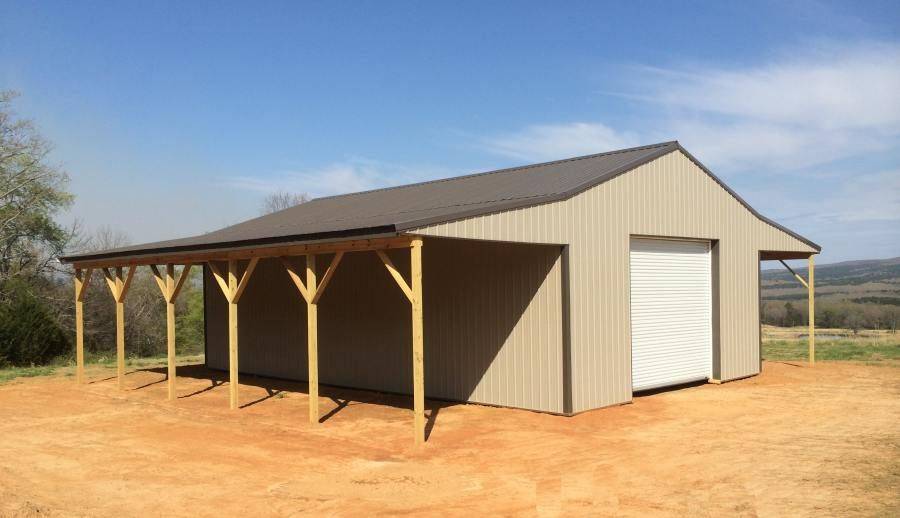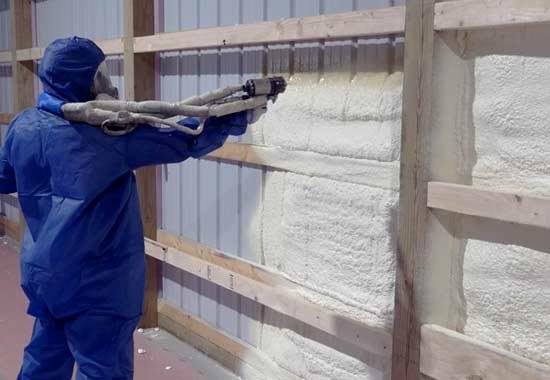Pole barns are a popular and cost-effective option for agricultural, commercial, and residential buildings. However, the exposed poles and open framing make insulating pole barns challenging compared to conventional construction. Spray foam insulation is an innovative solution that seals air gaps and provides superior thermal performance in pole barns.
Spray foam is a two-part liquid that mixes at the application nozzle to rapidly expand and cure in place. It conforms to the shape of spaces, sealing cracks and crevices. If you’ve been looking for a pole barn insulation solution for your space, let’s explore what spray foam has to offer.
The Benefits of Spray Foam for Pole Barns
Thermal Efficiency Advantages
Spray foam insulating material has a high R-value. In fact, closed-cell spray foam can have an R-value between R-6 and R-7.4 per inch, which is great for helping maintain consistent temperatures. By tightly sealing your pole barn building with spray foam, your HVAC systems run more efficiently. This can provide great cost savings in the long run.
Improved Temperature Regulation
The superior air sealing of spray foam insulation delivers more consistent indoor temperatures. Gaps in insulation act like chimneys drawing in outside air, creating cold spots and causing HVAC systems to work overtime.
Spray foam stops these convection currents for more uniform temperatures throughout the pole barn interior. Livestock and stored goods are protected from rapid temperature swings.
Controlling Moisture and Condensation
Open pole barns often suffer from condensation buildup and high interior humidity. Spray foam forms a vapor retarder stopping moisture migration into walls and attics. When properly installed, spray foam also helps protect metal and wood building components from moisture damage.
Effective Noise Dampening
The noise of rain, hail, and animals on metal roofing can make pole barns uncomfortably loud. Spray foam dampens exterior noise by sealing leaks and adding mass. By reducing echo, this insulation helps make the interior of the pole barn quieter.
Resisting Pests
Rodents, insects, and birds can nest in certain types of insulation. Spray foam leaves no gaps for pests to enter and contains no food material. If you use your pole barn to store animals or special products, it’s especially important to keep pests away. Spray foam does an excellent job of preventing these pests from entering.
How Spray Foam Insulation Works
Spray foam expands up to 30 times its liquid volume to fill every crack and seam. At the end of the process, spray foam cures into a seamless insulation blanket custom-fit to pole barn framing.
Closed-Cell vs Open-Cell Foam
Although a professional installer will be able to recommend the proper spray foam type for your pole barn, it helps to have an understanding of the two different types: open and closed cell foam.
Here are the key differences between the two.
- Structure and Density
- Open-Cell: Open-cell spray foam is less dense and has a more sponge-like structure. It is composed of tiny cells that are not completely closed, allowing air and moisture to penetrate to some extent.
- Closed-Cell: Closed-cell spray foam is denser and has a more rigid structure. Its cells are completely closed, preventing the passage of air and moisture.
- R-Value
- Open-Cell: Open-cell foam typically has a lower R-value (thermal resistance) per inch compared to closed-cell foam.
- Closed-Cell: Closed-cell foam has a higher R-value per inch, making it a more effective insulator. It provides better thermal resistance and can be used in thinner applications to achieve the same insulating effect as thicker layers of open-cell foam.
- Air and Moisture Barrier
- Open-Cell: While open-cell foam provides some insulation and can act as an air barrier, it is not a complete moisture barrier. It allows some moisture vapor to pass through it.
- Closed-Cell: Closed-cell foam acts as a complete air and moisture barrier due to its higher density and closed-cell structure. It is often used in applications where a moisture barrier is essential.
- Strength and Rigidity
- Open-Cell: Open-cell foam is less rigid and has some flexibility, which can be an advantage in certain applications, such as reducing the risk of cracking in wall assemblies.
- Closed-Cell: Closed-cell foam is rigid and provides structural support. It can add strength to building components.
- Cost
- Open-Cell: Open-cell foam is generally less expensive than closed-cell foam, making it an attractive option for cost-conscious projects.
- Closed-Cell: Closed-cell foam is more expensive due to its higher density and insulating properties. It is often used in situations where its specific characteristics are required.
- Installation
- Open-Cell: Open-cell foam is typically easier to install and can expand more rapidly than closed-cell foam.
- Closed-Cell: Closed-cell foam requires more precise installation and may have longer curing times.
- Applications
- Open-Cell: Open-cell foam is often used in interior applications, such as walls and ceilings, where moisture control is not a primary concern. It is also suitable for sound insulation.
- Closed-Cell: Closed-cell foam is commonly used in exterior applications and areas where moisture control and a higher R-value are important.
Professional Spray Foam Installation
As mentioned, professional insulation experts can recommend the type of spray foam needed to achieve maximum energy efficiency in your space. In addition, it’s important to hire professionals for installation.
Trained contractors use special equipment to spray foam components. High-pressure impingement mixers combine the resin and catalyst for precise mixing. Hoses heat the liquids to optimize reaction and spraying. Experienced installers carefully monitor flow rates, temperature, and expansion to achieve the specified thickness, density, and coverage.
Look to Cincinnati RetroFoam for Your Insulation Needs
If you’re seeking insulation for your pole barn, Cincinnati RetroFoam is here to help. We are the most trusted name in insulation in the Tri-State area and have worked on thousands of pole barns, livestock barns, equipment barns, and more, helping residents achieve a more energy-efficient lifestyle.
In addition to spray foam insulation, we offer blown-in and injection foam services. We also work on homes, new construction, and commercial properties. Let us help you create a more comfortable, efficient space. Request your quote today to get started.
Frequently Asked Questions
Does spray foam require protective covering?
Spray foams designed for exterior use are durable and do not require additional protection. Covering helps avoid damage from impact or UV light exposure.
Can spray foam get wet during application?
Water on surfaces will cause poor adhesion and curing problems. Surfaces should be checked with moisture meters before applying spray foam.
What is the spray foam insulation cost?
The cost of spray foam insulation depends on various factors including the size of your space, the complexity of the project, and more. The best way to determine the cost is to request a quote.


